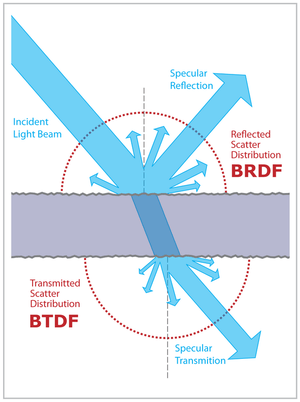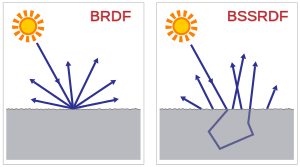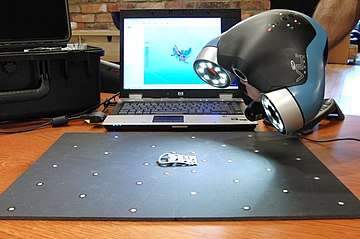Human image synthesis
Human image synthesis can be applied to make believable and even photorealistic renditions[1][2] of human-likenesses, moving or still. This has effectively been the situation since the early 2000s. Many films using computer generated imagery have featured synthetic images of human-like characters digitally composited onto the real or other simulated film material.

Timeline of human image synthesis
- In 1971 Henri Gouraud made the first CG geometry capture and representation of a human face. Modeling was his wife Sylvie Gouraud. The 3D model was a simple wire-frame model and he applied the Gouraud shader he is most known for to produce the first known representation of human-likeness on computer (view images).[3]
- The 1972 short film A Computer Animated Hand by Edwin Catmull and Fred Parke was the first time that computer-generated imagery was used in film to simulate moving human appearance. The film featured a computer simulated hand and face (watch film here).
- The 1976 film Futureworld reused parts of A Computer Animated Hand on the big screen.
- The 1983 music video for song Musique Non-Stop by German band Kraftwerk aired in 1986. Created by the artist Rebecca Allen, it features non-realistic looking, but clearly recognizable computer simulations of the band members.
- The 1994 film The Crow was the first film production to make use of digital compositing of a computer simulated representation of a face onto scenes filmed using a body double. Necessity was the muse as the actor Brandon Lee portraying the protagonist was tragically killed accidentally on-stage.
- In SIGGRAPH 2000 Paul Debevec et al. of USC presented a method to capture the reflectance field over the human face with their first version of a light stage.[4]

- In 2003 audience debut of photo realistic human-likenesses in the 2003 films The Matrix Reloaded in the burly brawl sequence where up-to-100 Agent Smiths fight Neo and in The Matrix Revolutions where at the start of the end showdown Agent Smith's cheekbone gets punched in by Neo leaving the digital look-alike unnaturally unhurt. The Matrix Revolutions bonus DVD documents and depicts the process in some detail and the techniques used, including facial motion capture and limbal motion capture, and projection onto models.
- In 2003 The Animatrix: Final Flight of the Osiris a state-of-the-art want-to-be human likenesses not quite fooling the watcher made by Square Pictures.
- In 2003 digital likeness of Tobey Maguire was made for movies Spider-man 2 and Spider-man 3 by Sony Pictures Imageworks.[5]
- In 2009 Debevec et al. presented new digital likenesses, made by Image Metrics, this time of actress Emily O'Brien whose reflectance was captured with the USC light stage 5[6] Motion looks fairly convincing contrasted to the clunky run in the Animatrix: Final Flight of the Osiris which was state-of-the-art in 2003 if photorealism was the intention of the animators.
- In 2009 a digital look-alike of a younger Arnold Schwarzenegger was made for the movie Terminator Salvation though the end result was critiqued as unconvincing. Facial geometry was acquired from a 1984 mold of Schwarzenegger.
- In 2010 Walt Disney Pictures released a sci-fi sequel entitled Tron: Legacy with a digitally rejuvenated digital look-alike of actor Jeff Bridges playing the antagonist CLU.
- In SIGGGRAPH 2013 Activision and USC presented a real time "Digital Ira" a digital face look-alike of Ari Shapiro, an ICT USC research scientist,[7] utilizing the USC light stage X by Ghosh et al. for both reflectance field and motion capture.[8] The end result both precomputed and real-time rendering with the modernest game GPU shown here and looks fairly realistic.
- In 2014 The Presidential Portrait by USC ICT in conjunction with the Smithsonian Institution was made using the latest USC mobile light stage wherein President Barack Obama had his geometry, textures and reflectance captured.[9]
- For the 2015 film Furious 7 a digital look-alike of actor Paul Walker who died in an accident during the filming was done by Weta Digital to enable the completion of the film.[10]
- In 2016 techniques which allow near real-time counterfeiting of facial expressions in existing 2D video have been believably demonstrated.[11]
- In 2016 a digital look-alike of Peter Cushing was made for the Rogue One film where its appearance would appear to be of same age as the actor was during the filming of the original 1977 Star Wars film.
- In SIGGRAPH 2017 an audio driven digital look-alike of upper torso of Barack Obama was presented by researchers from University of Washington. (view) It was driven only by a voice track as source data for the animation after the training phase to acquire lip sync and wider facial information from training material consisting 2D videos with audio had been completed.[12]
- Late 2017[13] and early 2018 saw the surfacing of the deepfakes controversy where porn videos were doctored utilizing deep machine learning so that the face of the actress was replaced by the software's opinion of what another persons face would look like in the same pose and lighting.
- In 2018 GDC Epic Games and Tencent Games demonstrated "Siren", a digital look-alike of the actress Bingjie Jiang. It was made possible with the following technologies: CubicMotion's computer vision system, 3Lateral's facial rigging system and Vicon's motion capture capture system. The demonstration ran in near real time at 60 frames per second in the Unreal Engine 4.[14]
Key breakthrough to photorealism: reflectance capture
In SIGGRAPH 2000 Paul Debevec et al. of USC presented their method to capture the reflectance field with their extremely simple light stage.[4]
The scientific breakthrough required finding the subsurface light component (the simulation models are glowing from within slightly) which can be found using knowledge that light that is reflected from the oil-to-air layer retains its polarization and the subsurface light loses its polarization. So equipped only with a movable light source, movable video camera, 2 polarizers and a computer program doing extremely simple math and the last piece required to reach photorealism was acquired.[4]
For a believable result both light reflected from skin (BRDF) and within the skin (a special case of BTDF) which together make up the BSDF must be captured and simulated.
Capture

- The 3D geometry and textures are captured onto a 3D model by sampling the target by means of 3D scanning with an RGB XYZ scanner such as Arius3d or Cyberware (textures from photos, not pure RGB XYZ scanner), stereophotogrammetrically from synchronized photos or even from enough repeated non-simultaneous photos.
- For believable results also the reflectance field must b.e captured or an approximation must be picked from the libraries to form a 7D reflectance model of the target.
Synthesis
The whole process of making digital look-alikes i.e. characters so lifelike and realistic that they can be passed off as pictures of humans is a very complex task as it requires photorealistically modeling, animating, cross-mapping, and rendering the soft body dynamics of the human appearance.
Synthesis with an actor and suitable algorithms is applied using powerful computers. The actor's part in the synthesis is to take care of mimicking human expressions in still picture synthesizing and also human movement in motion picture synthesizing. Algorithms are needed to simulate laws of physics and physiology and to map the models and their appearance, movements and interaction accordingly.
Often both physics/physiology based (i.e. skeletal animation) and image-based modeling and rendering are employed in the synthesis part. Hybrid models employing both approaches have shown best results in realism and ease-of-use.
Using displacement mapping plays an important part in getting a realistic result with fine detail of skin such as pores and wrinkles as small as 100 µm.
Applications
Main applications fall within the domains of virtual cinematography, computer and video games and covert disinformation attacks.
Furthermore, some research suggests that it can have therapeutic effects as "psychologists and counselors have also begun using avatars to deliver therapy to clients who have phobias, a history of trauma, addictions, Asperger’s syndrome or social anxiety."[15] The strong memory imprint and brain activation effects caused by watching a digital look-alike avatar of yourself is dubbed the doppelgänger effect.[15] The doppelgänger effect can heal when covert disinformation attack is exposed as such to the targets of the attack.
Related issues
The speech synthesis is verging on being completely indistinguishable from a real human's voice with the 2016 introduction of audio generation software Adobe Voco, a prototype slated to be a part of the Adobe Creative Suite and DeepMind WaveNet, a prototype from Google.[16] Ability to steal and manipulate other peoples voices raises obvious ethical concerns. [17]
This coupled with the fact that (as of 2016) techniques which allow near real-time counterfeiting of facial expressions in existing 2D video have been believably demonstrated increases the stress on the disinformation situation.[11]
See also
References
- ↑ Physics-based muscle model for mouth shape control on IEEE Explore (requires membership)
- ↑ Realistic 3D facial animation in virtual space teleconferencing on IEEE Explore (requires membership)
- ↑ "Images de synthèse : palme de la longévité pour l'ombrage de Gouraud".
- 1 2 3 Debevec, Paul (2000). "Acquiring the reflectance field of a human face". ACM. doi:10.1145/344779.344855. Retrieved 2017-05-24.
- ↑ Pighin, Frédéric. "Siggraph 2005 Digital Face Cloning Course Notes" (PDF). Retrieved 2017-05-24.
- ↑ In this TED talk video at 00:04:59 you can see two clips, one with the real Emily shot with a real camera and one with a digital look-alike of Emily, shot with a simulation of a camera - Which is which is difficult to tell. Bruce Lawmen was scanned using USC light stage 6 in still position and also recorded running there on a treadmill. Many, many digital look-alikes of Bruce are seen running fluently and natural looking at the ending sequence of the TED talk video.
- ↑ ReForm - Hollywood's Creating Digital Clones (youtube). The Creators Project. 2017-05-24.
- ↑ Debevec, Paul. "Digital Ira SIGGRAPH 2013 Real-Time Live". Retrieved 2017-05-24.
- ↑ "Scanning and printing a 3D portrait of President Barack Obama". University of Southern California. 2013. Retrieved 2017-05-24.
- ↑ Giardina, Carolyn (2015-03-25). "'Furious 7' and How Peter Jackson's Weta Created Digital Paul Walker". The Hollywood Reporter. Retrieved 2017-05-24.
- 1 2 Thies, Justus (2016). "Face2Face: Real-time Face Capture and Reenactment of RGB Videos". Proc. Computer Vision and Pattern Recognition (CVPR), IEEE. Retrieved 2017-05-24.
- ↑ Suwajanakorn, Supasorn; Seitz, Steven; Kemelmacher-Shlizerman, Ira (2017), Synthesizing Obama: Learning Lip Sync from Audio, University of Washington, retrieved 2018-03-02
- ↑ Roettgers, Janko (2018-02-21). "Porn Producers Offer to Help Hollywood Take Down Deepfake Videos". Variety. Retrieved 2018-02-28.
- ↑ Takahashi, Dean (2018-03-21). "Epic Games shows off amazing real-time digital human with Siren demo". VentureBeat. Retrieved 2018-09-10.
- 1 2 Murphy, Samantha (2011). "Scientific American: Your Avatar, Your Guide" (.pdf). Scientific American / Uni of Stanford. Retrieved 2013-06-29.
- ↑ "WaveNet: A Generative Model for Raw Audio". Deepmind.com. 2016-09-08. Retrieved 2017-05-24.
- ↑ "Adobe Voco 'Photoshop-for-voice' causes concern". BBC.com. BBC. 2016-11-07. Retrieved 2016-07-05.